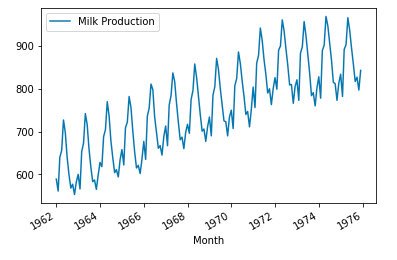早前,我介绍了循环神经网络(RNN)的基本概念,这篇文章我们就用Keras搭建一个RNN网络。该RNN能够通过对历史数据的学习,预测未来数据。
同样的,为了方便与读者交流,所有的代码都放在了这里:
Repository:
https://github.com/zht007/tensorflow-practice
1. GRU和LSTM简介
GRU(Gated Recurrent Unit)和LSTM(Long Short Term Memory)都是改进的RRN结构,为了解决深度RNN中容易出现的Vanishing Gradient(梯度消失)的问题。
关于梯度消失和梯度爆炸有机会可以单独介绍,简单来说就是浅层神经元在传递过程中由于多次的累乘作用,其权重趋近于无穷大或者趋近于零的现象,从而无法再有效地学习。
梯度消失和梯度爆炸在深度神经网络中非常容易出现,对于RNN来说,梯度消失现象尤为明显。RNN通常处理时间序列的问题,位于时间轴前面的信息很容易在深度网络中由于梯度消失现象,很容易就被"遗忘"掉。
GRU和LSTM就是加入了记忆的功能,从而有效地解决了这个问题。LSTM有Forget Gate和 Update Gate,而GRU简化成了一个Gate。目前GRU由于占用资源更少在大多数情况下已经够用了。
2. 数据导入和查看
本文的数据来自这里with open lisence,这个数据集记录了从1962年到1975年某地每个月牛奶的产量,是一个典型的有规律的时间序列数据,如下图。
注意,源代码中文将数据放在了Google Drive中方便在Colab中直接处理,也可以将csv文件放在本地,在本地运行。
milk.plot()

3. 数据预处理
首先,我们将数据分为训练组和验证组,这里一共有14年的数据,我将前13年的数据用于训练,最后一年的数据用于验证。
train_set= milk.head((1976-1962-1)*12)
test_set = milk.tail(12)
然后,我们用sklearn的MinMax工具对数据进行归一化处理。
from sklearn.preprocessing import MinMaxScaler
scaler = MinMaxScaler()
train_scaled = scaler.fit_transform(train_set)
test_scaled = scaler.transform(test_set)
接着,我们需要对训练集的数据再次处理以符合RNN和GUR的输入输出的Shape。
设计一个连续的数据窗口,窗口中包含13个月的数据。
由于是多对一的结构,前12个月数据X为输入的Feature,后1个月数据为label与神经网络的输出做对比。
数据窗口按月平移,这样一共可以产生12*12个组数据。
def build_train_data(data, past_monthes = 12, future_monthes = 1):
X_train, Y_train = [],[]
for i in range(data.shape[0] + 1 - past_monthes - future_monthes):
X_train.append(np.array(data[i:i + past_monthes]))
Y_train.append(np.array(data[i + past_monthes:i + past_monthes + future_monthes]))
return np.array(X_train).reshape([-1,12]), np.array(Y_train).reshape([-1,1])
于是我们通过这个帮助函数得到输入和输出
x, y = build_train_data(train_scaled)
4. GRU的输入与输出
from tensorflow.keras import layers, Sequential,models
RNN_CELLSIZE = 10
SEQLEN = 12
BATCHSIZE = 10
如下图所示,
输入:X shape [BATCHSIZE, SEQLEN, 1],SEQLEN是输入步长,这里为12。
输出:Y shape [BATCHSIZE, SEQLEN, 1],但是我们这里是多对一的结构,仅取最后一位即可。
状态:H shape [BATCHSIZE, RNN_CELLSIZE*N_LAYERS], RNN_CELLSIZE是每一层GRU个数,N_LAYERS是神经网络的深度(层数)
image source from github with lisence Apache-2.0
5. GRU神经网络
5.1 单层GRU结构
在Keras中,Batchsize是隐性表示出来的,所以不必给出。Reshape的目的是保证X shape 为[BATCHSIZE, SEQLEN, 1]。GRU默认只输出Y的最后一位,最后通过单神经元全连接层输出。
model_layers = [
layers.Reshape((SEQLEN,1),input_shape=(SEQLEN,)),
layers.GRU(RNN_CELLSIZE),
layers.Dense(1)
]
model = Sequential(model_layers)
model.summary()
------OUTPUT-------------
Layer (type) Output Shape Param #
=================================================================
reshape (Reshape) (None, 12, 1) 0
_________________________________________________________________
gru (GRU) (None, 10) 630
_________________________________________________________________
dense (Dense) (None, 1) 11
=================================================================
部分代码参考 github with lisence Apache-2.0
5.2 两(多)层GRU结构
在Keras中增加GRU中间层,需要设置return_sequences=True,中间所有的输出都可以传到下一层,而不是默认的只输出最后一位。
model_layers = [
layers.Reshape((SEQLEN,1),input_shape=(SEQLEN,)),
layers.GRU(RNN_CELLSIZE, return_sequences=True),
layers.GRU(RNN_CELLSIZE),
layers.Dense(1)
]
model = Sequential(model_layers)
model.summary()
------OUTPUT-------------
Layer (type) Output Shape Param #
=================================================================
reshape (Reshape) (None, 12, 1) 0
_________________________________________________________________
gru (GRU) (None, 12, 10) 360
_________________________________________________________________
gru_1 (GRU) (None, 10) 630
_________________________________________________________________
dense (Dense) (None, 1) 11
=================================================================
部分代码参考 github with lisence Apache-2.0
5.3 模型的训练
这里模型compile 和 模型 fit 与之前CNN没有太大区别
model.compile(
loss = 'mean_squared_error',
optimizer = 'adam'
)
h = model.fit(x,y, batch_size=BATCHSIZE,
epochs = 1000)
可以看到经过1000个epoch的训练,在样本不大的情况下损失函数稳定在0.02左右。

6. 模型的预测
6.1 预测最后一年
对于多对一的模型,由于每输入12个月只能预测1个月的结果,我们需要取训练集中最后一年12个月的产量,来预测下一年中第一个月的产量。然后再将这个月预测的产量放进输入以预测第二个月的产量,如此循环12次便能预测全年的产量了。
我们需要一个帮助函数:
def get_prediction(data_list):
predict = []
train_seed = data_list
for i in range(12):
x_train = np.array(train_seed[-12:]).reshape(1,12)
one_predict = model.predict(x_train)[0][0]
predict.append(one_predict)
train_seed.append(one_predict)
return predict, train_seed
将训练集中最后12个月的数据取出,来预测下一年的产量。
train_seed = list(train_scaled[-12:].flatten())
predict, train_seed = get_prediction(train_seed)
经过一些简单处理,我们可以看到预测结果和实际结果(测试集数据)之间的对比。

6.2 进一步预测
当然我们也可以仅用第一年的数据来预测所有之后的数据,结果如下,具体过程可参考源码。

总结
本文通过Keras实现了单层或多层GRU结构,采用多对一的结构,通过前12个月牛奶的产量成功预测下一个月的产量。我们是否可以采用多对多的结构,用前12个月的产量预测后12个月的产量呢?答案当然是肯定的,这个问题将在下一篇文中解答。
参考资料
[1]https://codelabs.developers.google.com/codelabs/cloud-tensorflow-mnist/#0
[2]https://github.com/GoogleCloudPlatform/tensorflow-without-a-phd.git
[3]https://www.tensorflow.org/api_docs/
相关文章
Tensorflow入门——单层神经网络识别MNIST手写数字
Tensorflow入门——多层神经网络MNIST手写数字识别
Tensorflow入门——分类问题cross_entropy的选择
同步到我的简书

已修复,Open License 链接已加
This post has been voted on by the SteemSTEM curation team and voting trail. It is elligible for support from @curie.
If you appreciate the work we are doing, then consider supporting our witness stem.witness. Additional witness support to the curie witness would be appreciated as well.
For additional information please join us on the SteemSTEM discord and to get to know the rest of the community!
Please consider setting @steemstem as a beneficiary to your post to get a stronger support.
Please consider using the steemstem.io app to get a stronger support.